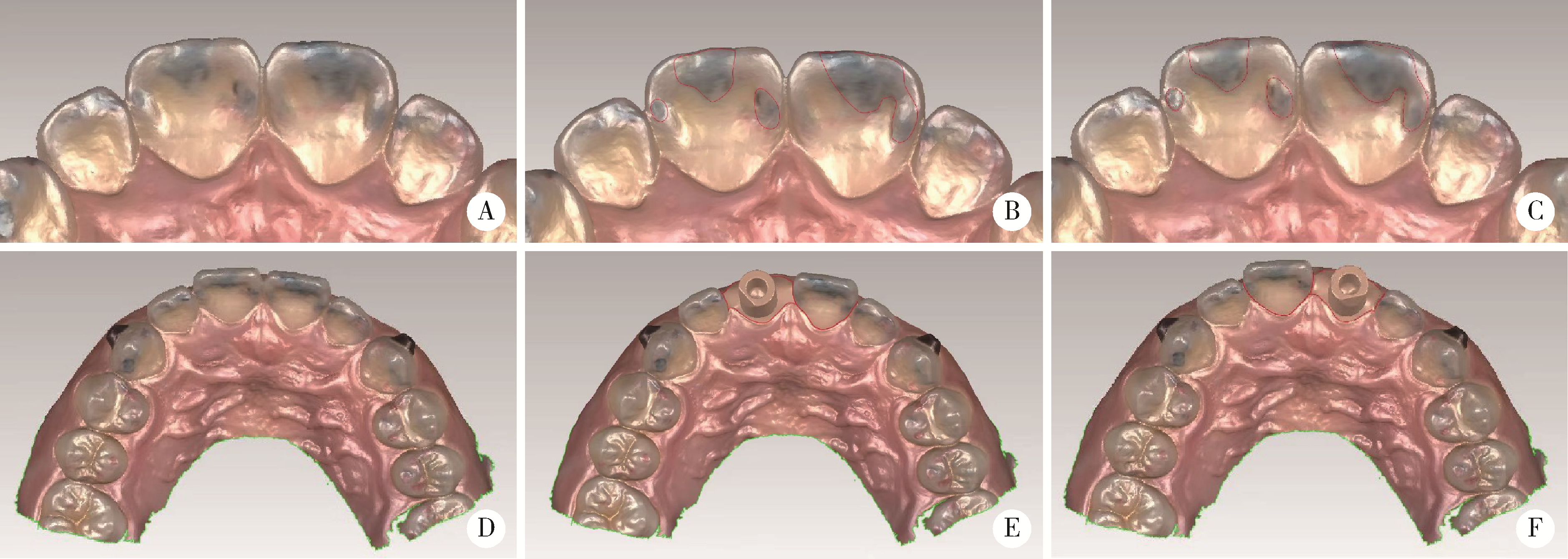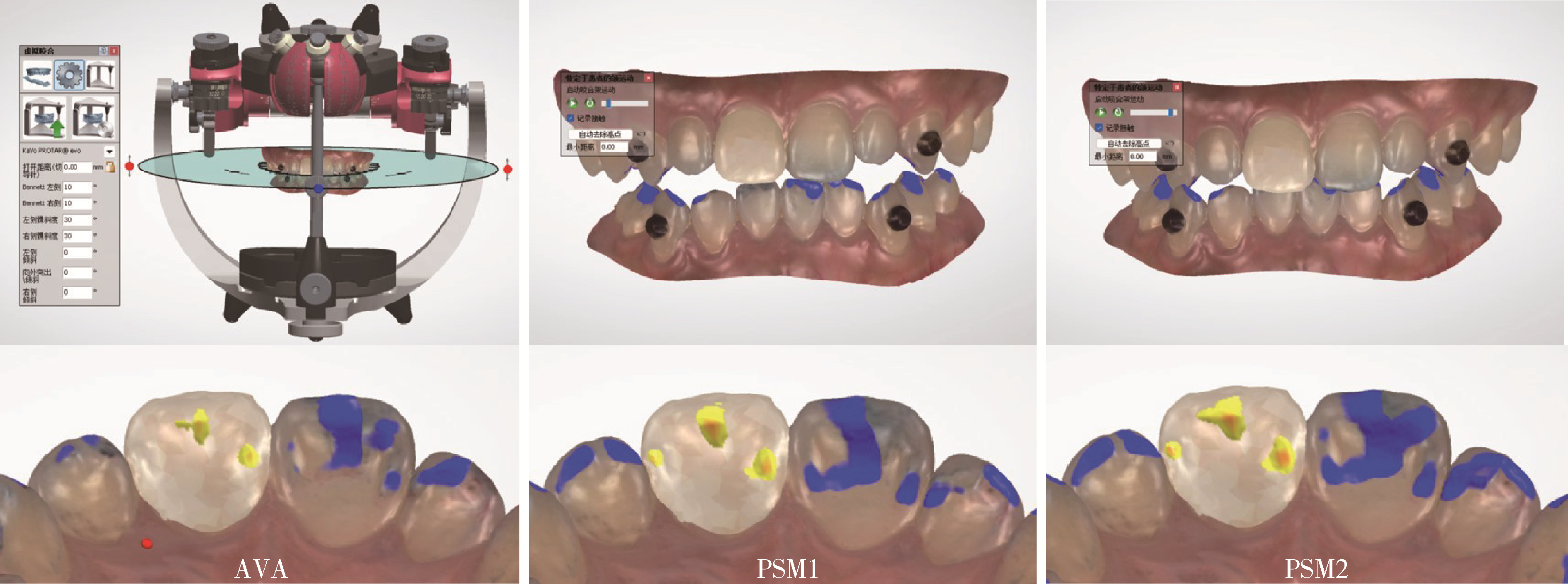Journal of Peking University (Health Sciences) ›› 2024, Vol. 56 ›› Issue (1): 81-87. doi: 10.19723/j.issn.1671-167X.2024.01.013
Previous Articles Next Articles
Trueness of different digital design methods for incisal guidance of maxillary anterior implant-supported single crowns
Sui LI1,Wenjie MA1,Shimin WANG2,Qian DING1,*( ),Yao SUN1,Lei ZHANG1,*(
),Yao SUN1,Lei ZHANG1,*( )
)
- 1. Department of Prosthodontics, Peking University School and Hospital of Stomatology & National Center for Stomatology & National Clinical Research Center for Oral Diseases & National Engineering Research Center of Oral Biomaterials and Digital Medical Devices & Beijing Key Laboratory of Digital Stomatology, Beijing 100081, China
2. Center of Dental Laboratory, Peking University School and Hospital of Stomatology & National Center for Stomatology & National Clinical Research Center for Oral Diseases & National Engineering Research Center of Oral Biomaterials and Digital Medical Devices & Beijing Key Laboratory of Digital Stomatology, Beijing 100081, China
CLC Number:
- R782.1
| 1 | 谢秋菲. 临床牙合学:成功修复指导[M]. 2版.北京: 科学出版社, 2014: 33- 34. |
| 2 | 韩科, 张豪. 牙合学理论与临床实践[M]. 北京: 人民军医出版社, 2008: 45. |
| 3 | 塔兰托, 张富强. 修复与牙合重建临床病例解析[M]. 沈阳: 辽宁科学技术出版社, 2013: 46. |
| 4 | Stoichkov B , Kirov D . Analysis of the causes of dental implant fracture: A retrospective clinical study[J]. Quintessence Int, 2018, 49 (4): 279- 286. |
| 5 |
Yuan JC , Sukotjo C . Occlusion for implant-supported fixed dental prostheses in partially edentulous patients: A literature review and current concepts[J]. J Periodontal Implant Sci, 2013, 43 (2): 51- 57.
doi: 10.5051/jpis.2013.43.2.51 |
| 6 |
Klineberg I , Kingston D , Murray G . The bases for using a particular occlusal design in tooth and implant-borne reconstructions and complete dentures[J]. Clin Oral Implants Res, 2008, 19 (3): 326- 328.
doi: 10.1111/j.1600-0501.2007.01549.x |
| 7 | Gross MD . Occlusion in implant dentistry: A review of the literature of prosthetic determinants and current concepts[J]. Aust Dent J, 2008, 53 (1): S60- S68. |
| 8 |
Taylor TD , Wiens J , Carr A . Evidence-based considerations for removable prosthodontic and dental implant occlusion: A literature review[J]. J Prosthet Dent, 2005, 94 (6): 555- 560.
doi: 10.1016/j.prosdent.2005.10.012 |
| 9 |
Lepidi L , Suriano C , Wang HL , et al. Digital fixed complete-arch rehabilitation: From virtual articulator mounting to clinical delivery[J]. J Prosthet Dent, 2022, 127 (3): 398- 403.
doi: 10.1016/j.prosdent.2020.08.049 |
| 10 |
Valenti M , Schmitz JH . A reverse digital workflow by using an interim prosthesis scan and patient-specific motion with an intraoral scanner[J]. J Prosthet Dent, 2021, 126 (1): 19- 23.
doi: 10.1016/j.prosdent.2020.05.011 |
| 11 |
Lee YC , Lee CN , Shim JS , et al. Comparison between occlusal errors of single posterior crowns adjusted using patient-specific motion or conventional methods[J]. Applied Sciences, 2020, 10 (24): 9140.
doi: 10.3390/app10249140 |
| 12 |
Li L , Chen H , Li W , et al. Design of wear facets of mandibular first molar crowns by using patient-specific motion with an intraoral scanner: A clinical study[J]. J Prosthet Dent, 2023, 129 (5): 710- 717.
doi: 10.1016/j.prosdent.2021.06.048 |
| 13 |
Ke Y , Zhang Y , Wang Y , et al. Comparing the accuracy of full-arch implant impressions using the conventional technique and digital scans with and without prefabricated landmarks in the mandible: An in vitro study[J]. J Dent, 2023, 135, 104561.
doi: 10.1016/j.jdent.2023.104561 |
| 14 |
Kanjanasavitree P , Thammajaruk P , Guazzato M . Comparison of different artificial landmarks and scanning patterns on the complete-arch implant intraoral digital scans[J]. J Dent, 2022, 125, 104266.
doi: 10.1016/j.jdent.2022.104266 |
| 15 | Tao C , Zhao YJ , Sun YC , et al. Accuracy of intraoral scanning of edentulous jaws with and without resin markers[J]. Chin J Dent Res, 2020, 23 (4): 265- 271. |
| 16 | Richert R , Goujat A , Venet L , et al. Intraoral scanner technologies: A review to make a successful impression[J]. J Healthc Eng, 2017, 2017, 8427595. |
| 17 |
Ireland AJ , McNamara C , Clover MJ , et al. 3D surface imaging in dentistry: What we are looking at[J]. Br Dent J, 2008, 205 (7): 387- 392.
doi: 10.1038/sj.bdj.2008.845 |
| 18 |
Aubreton O , Bajard A , Verney B , et al. Infrared system for 3D scanning of metallic surfaces[J]. Mach Vision Appl, 2013, 24 (7): 1513- 1524.
doi: 10.1007/s00138-013-0487-z |
| 19 |
Parl HS , Shah C . Development of high speed and high accuracy 3D dental intraoral scanner[J]. Procedia Eng, 2015, 100, 1174- 1181.
doi: 10.1016/j.proeng.2015.01.481 |
| 20 |
Li L , Chen H , Li W , et al. The effect of residual dentition on the dynamic adjustment of wear facet morphology on a mandibular first molar crown[J]. J Prosthodont, 2021, 30 (4): 351- 355.
doi: 10.1111/jopr.13290 |
| 21 |
Li L , Chen H , Zhao Y , et al. Design of occlusal wear facets of fixed dental prostheses driven by personalized mandibular movement[J]. J Prosthet Dent, 2022, 128 (1): 33- 41.
doi: 10.1016/j.prosdent.2020.09.055 |
| 22 |
Chen H , Yang X , Li L , et al. Morphological design of occlusal wear facets for the mandibular first molar crown using different bite registration methods[J]. J Prosthodont, 2023, 32 (5): 439- 444.
doi: 10.1111/jopr.13574 |
| 23 | 朱家奕, 王俊杰, 王宇轩, 等. 轻咬合和重咬合状态对下颌运动轨迹及虚拟预调牙合的影响[J]. 中华口腔医学杂志, 2023, 58 (1): 50- 56. |
| 24 | Li R , Zhang R , Zhou Y , et al. Accuracy of two best-fit alignment strategies with different reference areas for wear measurement with an intraoral scanner: An in vitro study[J]. Int J Comput Dent, 2023, 26 (4): 331- 337. |
| [1] | Han ZHANG,Yixuan QIN,Diyuan WEI,Jie HAN. A preliminary study on compliance of supportive treatment of patients with periodontitis after implant restoration therapy [J]. Journal of Peking University (Health Sciences), 2024, 56(1): 39-44. |
| [2] | Xinyu XU,Ling WU,Fengqi SONG,Zili LI,Yi ZHANG,Xiaojing LIU. Mandibular condyle localization in orthognathic surgery based on mandibular movement trajectory and its preliminary accuracy verification [J]. Journal of Peking University (Health Sciences), 2024, 56(1): 57-65. |
| [3] | Congwei WANG,Min GAO,Yao YU,Wenbo ZHANG,Xin PENG. Clinical analysis of denture rehabilitation after mandibular fibula free-flap reconstruction [J]. Journal of Peking University (Health Sciences), 2024, 56(1): 66-73. |
| [4] | Xiaoqiang LIU,Yin ZHOU. Risk factors of perioperative hypertension in dental implant surgeries with bone augmentation [J]. Journal of Peking University (Health Sciences), 2024, 56(1): 93-98. |
| [5] | Qian DING,Wen-jin LI,Feng-bo SUN,Jing-hua GU,Yuan-hua LIN,Lei ZHANG. Effects of surface treatment on the phase and fracture strength of yttria- and magnesia-stabilized zirconia implants [J]. Journal of Peking University (Health Sciences), 2023, 55(4): 721-728. |
| [6] | Meng-en OU,Yun DING,Wei-feng TANG,Yong-sheng ZHOU. Three-dimensional finite element analysis of cement flow in abutment margin-crown platform switching [J]. Journal of Peking University (Health Sciences), 2023, 55(3): 548-552. |
| [7] | Fei SUN,Jian LIU,Si-qi LI,Yi-ping WEI,Wen-jie HU,Cui WANG. Profiles and differences of submucosal microbial in peri-implantitis and health implants: A cross-sectional study [J]. Journal of Peking University (Health Sciences), 2023, 55(1): 30-37. |
| [8] | FENG Sha-wei,GUO Hui,WANG Yong,ZHAO Yi-jiao,LIU He. Initial establishment of digital reference standardized crown models of the primary teeth [J]. Journal of Peking University (Health Sciences), 2022, 54(2): 327-334. |
| [9] | LI Yi,YU Hua-jie,QIU Li-xin. Clinical classification and treatment decision of implant fracture [J]. Journal of Peking University (Health Sciences), 2022, 54(1): 126-133. |
| [10] | LI Yi,WONG Lai U,LIU Xiao-qiang,ZHOU Ti,LYU Ji-zhe,TAN Jian-guo. Marginal features of CAD/CAM laminate veneers with different materials and thicknesses [J]. Journal of Peking University (Health Sciences), 2022, 54(1): 140-145. |
| [11] | WANG Juan,YU Hua-jie,SUN Jing-de,QIU Li-xin. Application evaluation of prefabricated rigid connecting bar in implants immediate impression preparation of edentulous jaw [J]. Journal of Peking University (Health Sciences), 2022, 54(1): 187-192. |
| [12] | QIU Shu-ting,ZHU Yu-jia,WANG Shi-min,WANG Fei-long,YE Hong-qiang,ZHAO Yi-jiao,LIU Yun-song,WANG Yong,ZHOU Yong-sheng. Preliminary clinical application verification of complete digital workflow of design lips symmetry reference plane based on posed smile [J]. Journal of Peking University (Health Sciences), 2022, 54(1): 193-199. |
| [13] | Feng LIANG,Min-jie WU,Li-dong ZOU. Clinical observation of the curative effect after 5-year follow-up of single tooth implant-supported restorations in the posterior region [J]. Journal of Peking University (Health Sciences), 2021, 53(5): 970-976. |
| [14] | LIU Xiao-qiang,YANG Yang,ZHOU Jian-feng,LIU Jian-zhang,TAN Jian-guo. Blood pressure and heart rate changes of 640 single dental implant surgeries [J]. Journal of Peking University (Health Sciences), 2021, 53(2): 390-395. |
| [15] | XU Xiao-xiang,CAO Ye,ZHAO Yi-jiao,JIA Lu,XIE Qiu-fei. In vitro evaluation of the application of digital individual tooth tray in the impression making of mandibular full-arch crown abutments [J]. Journal of Peking University (Health Sciences), 2021, 53(1): 54-61. |
|
||







